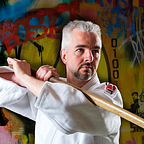Why Scrum needs Product Leadership
Welcome to the third wave of Agile adoption — an age where organizations
reinvent themselves around self organisation and empericsm, and, if done well, the power trickles down to the people. These are the people who have the knowledge to make the best decisions, but this has exposed a new kind of problem.
The Problem With the Product Owner Role
When Ken Schwaber and Jeff Sutherland created Scrum, they envisioned a different kind of leader. One who “owns” the product, knows its value, and, brings it to the market together with the Scrum master and development team. They disliked the word “manager,” which derives from Latin-French and loosely translated means “he who makes the horses go faster.” Instead, they coined a new term for the role, “product owner.”
The revised concept and role promised to improve everything — instead of directing managers we would get inspirational leaders who were passionate about the problems their products solve for their customers. We would get great visionaries that discovered how to create products that matter.
“Rally the team! It will be fun!” cried the promise. There was only one problem — nobody knew how.
Bottom line, that’s the beauty of Scrum. It’s a simple framework for effective team collaboration on complex products, nothing more nothing less. It doesn’t tell you how to inspire teams or how to lead them. Instead, it leaves you to figure out how for yourself.
Trust and Safety
Over the past few years, we’ve observed that most product owners have grasped empiricism and mastered techniques like business model canvassing, contextual inquiry, data analytics, maintaining an ordered backlog, and explaining value. However, no matter how highly motivated, smart, and skilled, some product owners make an impact while others don’t. Why?
The answer may lie in how the brain works.
On a biochemical level, the human brain continually scans the environment with a single question, “Am I safe?” It won’t allow us to take another breath or step forward if the answer to that question feels like “no.” Since the product owner is a leader who must get people moving, this is a critical insight. People won’t start moving towards a product owner’s vision or goal until they are sure they are safe.
The discriminating factor between successful and unsuccessful product owners lies in their ability to build trust and a safe environment.
Trust depends on the credibility and reliability of the product owner, how much she or he shares with the team. Does their vision reflect a genuine desire to help the customer or to propel their career? Product owners that get the mix right are substantially more effective.
Handling Resistance
Another critical difference is the way successful product owners transform resistance into commitment. These are the leaders who proactively confront team members and stakeholders who don’t see a problem and create awareness.
The mind is like a parachute — it works better if it’s open. People can’t be motivated to solve a problem or seize an opportunity until they can accept and understand new information. So, the best product owners recognize this and foster an environment that nurtures learning. Instead of tossing inspiration around like seeds, they make sure that it takes root.
Stakeholder Management
“With great power comes great responsibility,” so says Churchill, Roosevelt, (and Spiderman.) The statement actually derives from a set of decrees set forth at the French National Convention in 1793, “Great responsibility follows
inseparably from great power.” So, if product owners become product leaders they are more like the mini-CEO of a product. This means the profit and loss of their product should also fall on their shoulders. Ironically, the more “power” they gain, the less they can use.
“The Six Leadership Styles for Effective Team Performance” by Daniel Goleman is a great resource for product owners that operate at this CEO-level and need to switch effortlessly between leadership styles according to the stakeholder field, urgency or importance. These product owners build relationships and focus on making collaborative decisions.
They also coach the development team to expand their span by giving them more autonomy. In a crisis, they know when to apply a more powerful approach or roll up their sleeves and set the pace. Third-wave product leaders must know when to apply what style on an individual and group level.
About Product Leadership
In many ways, leading the product is a lot like practicing martial arts.
It’s not about mastering a collection of techniques; it’s about the interplay between them — knowing when to apply what, inspecting what works, and then adapting to improve.
The Scrum framework is often criticized for not giving product owners enough tools in the realm of product management. However, much like a dojo (the room where martial arts are practiced), Scrum does provide the perfect conditions for people to grow on their path.
Product leadership is not about pushing people to go faster; it’s about learning how to own the product and nurturing it to fruition.
